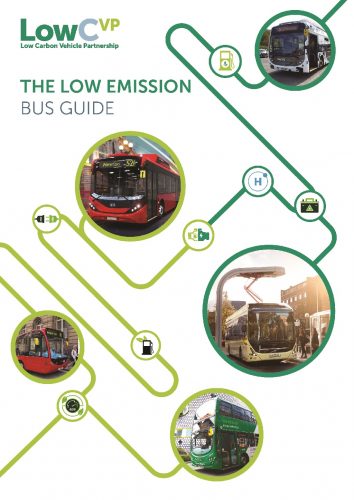
The new publication, launched at Euro Bus Expo 2016, aims to help inform purchasing decisions on new low emission vehicles
The Low Carbon Vehicle Partnership (LowCVP) has launched the Low Emission Bus (LEB) Guide at the Euro Bus Expo 2016.
The Guide aims to be a vital reference for bus operators and local authorities, providing an overview of the benefits of a range of low emission fuels and technologies to aid purchasing decisions, and encourage the adoption of the most appropriate low emission bus technology and associated infrastructure for particular routes and applications.
The publication covers a range of technologies, including electric, hybrid, plug-in hybrid, electrified ancillaries, hydrogen fuel cell, biomethane, renewable diesel and retrofit selective catalytic reduction. It outlines both the emissions performance and the operational and financial factors fleet operators should consider when procuring new buses and the associated infrastructure requirements and implications. Real-world bus operator case studies are provided to highlight and demonstrate the environmental and business cases for the range of different technologies and fuels.
Transport Minister John Hayes said: “Buses are the most popular form of public transport and millions of people rely on them every day. Low emission vehicles can make a real difference to air quality in towns and cities, which is why we have committed £30m to help pay for more than 300 new cleaner buses.
“This guide will give operators and councils the information they need to adopt these greener vehicles.”
The LowCVP’s Managing Director, Andy Eastlake, said: “Maintaining our ability to move around in increasingly congested towns and cities is more critical today than ever before.
“With road transport responsible for around a quarter of the UK’s greenhouse gas emissions and up to 60% of roadside NOx pollution in many cities around the UK, the introduction of cleaner, low emission buses is a key component – and a good example – of how we can achieve a low emission transport future.
“The new LEB Guide provides clear yet comprehensive advice about which bus fuels and technologies are best suited to a range of operating conditions.”
Stuart Cottrell, Head of Advanced Engineering, Alexander Dennis Ltd, commented: “There are few easy answers to the complex question of which low emission technology is best for each operator, route and service requirements – no one size fits all.
“While ADL strives to provide the best options across the cost-benefit spectrum, it’s key that the whole landscape is understood.
“Providing clear, independent information on the range of low and zero emission technologies in the bus sector is key to driving informed debate and fact-based decisions.”
Frank Thorpe, UK Country Manager, BYD, added: “As the world’s largest maker of pure electric buses, BYD recognises the complex task facing operators as they work out which technologies to choose.
“We are convinced that battery-powered buses are the way forward in terms of ease and cost of operation and their related infrastructure. We welcome the publication of this Guide and the clarity it brings to the industry.”
Carlos Vicente, International Business Development Manager at Eminox, said: “I think this guide will really help bus operators to make informed choices about replacing or upgrading vehicles, and of course we’re delighted to see SCRT technology recognised for its potential to improve air quality.”
Tony Griffiths of the Gas Bus Alliance commented: “The Gas Bus Alliance is proud to be part of the development of the LEB Guide that confirms biomethane as the cleanest option available in terms of well-to-wheel emissions.”
James Salmon, Project Manager UK at HJS Emission Technology, said: “HJS Emission Technology is pleased to have worked in partnership with the LowCVP on the production of the LEB Guide.
“The Guide provides an essential insight into the air quality issues faced by the public transport industry and the environmental technologies that are available to tackle them.”
Robert Drewery, Commercial Director at Optare, said: “As the leading electric bus manufacturer in the UK we are delighted to support the LowCVP’s LEB Guide.
“It is a much-needed source of information that will support operators in reviewing infrastructure requirements and implications as well as financial factors when considering alternative technologies. We hope the Guide will inspire the purchase of more low emission vehicles and help in the industry’s quest to limit climate change and improve local air quality.”
Adrian Felton, City Mobility Manager at Volvo Group UK Ltd, concluded: “The release of the LEB Guide is a significant step forward in helping local authorities and operators to select the right technology for their city and operation.
“The Volvo Group has a long-standing relationship with the LowCVP which continues to develop and is delighted to have been able to support the production of the LEB Guide.
“The aims of the LowCVP have many similarities with those of the Volvo Group which aims to become the world leader in sustainable low emission transport systems.”
The publication is available at www.lowcvp.org.uk/resource-library/reports-and-studies

